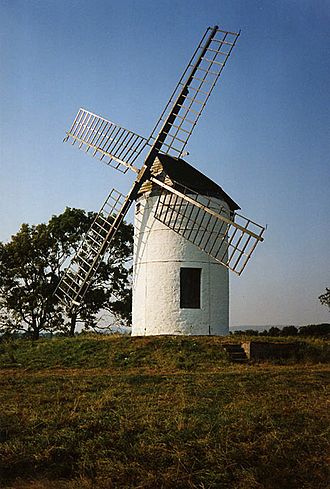Ashton Windmill facts for kids
Quick facts for kids Ashton windmill |
|
|---|---|
 |
|
| General information | |
| Architectural style | Tower mill |
| Town or city | Chapel Allerton, Somerset |
| Country | England |
| Coordinates | 51°14′56″N 2°50′24″W / 51.248828°N 2.840119°W |
Ashton Windmill is a special old building in Chapel Allerton, Somerset, England. It's a type of windmill called a tower mill. This mill is so important that it has been named a Grade II* listed building by English Heritage. This means it's a very important historical site that needs to be protected.
This windmill is a classic example of a Somerset tower mill. It is built from stone that has been painted a light color. It has a top part that can turn around, called a revolving cap, and a tailfan. It also has four large sails. The tower stands about 7.5 meters (25 feet) tall. Its walls are 60 centimeters (2 feet) thick! The sails stretch 13 meters (43 feet) across.
The mill used to grind grain. Its last millstones were 1.2 meters (4 feet) wide. Imagine, this windmill could grind 400 kilograms (880 pounds) of corn in just one hour! It also ground beans to feed farm animals. Today, Ashton Windmill is the only one in Somerset that still has all its working parts. Local volunteers open it for visitors a couple of afternoons each week during the summer. It's free to visit, but donations help keep it running.
Contents
The Story of Ashton Windmill
The history of Ashton Windmill is very well known. The first record of a mill on this spot dates all the way back to 1317. That first mill was probably a different type, called a postmill. We even know the names of the millers who worked here from 1737 until 1927. One of the last workers, Tom Petheram, shared his memories of life at the mill.
Building the Current Mill
The windmill you see today was built in the 1760s. The Paine family built it, and they likely reused some of the wooden parts from the older mill.
For a short time around the 1890s, the mill was powered by steam instead of wind. In 1900, the owner, John Stevens, gave the mill a big makeover. He replaced the old machinery with parts from another mill called Moorlinch Mill. The original roof, which was made of thatch, was rebuilt and covered with corrugated iron. Two of the wide sails were replaced with spring sails, and iron bands were added around the building to make it stronger.
Later Years and Restoration
Ashton Windmill stopped working in 1927. This happened because corn prices were low, and bigger mills powered by steam were taking over. During World War Two, the mill was used by the Home Guard, a defense organization.
The windmill has been repaired and updated many times. In 1958, the stone walls were fixed, and a new boat-shaped roof, new doors, and new sails were put in place. In 1979, the whole building and its inside parts were carefully restored. Newer steel parts for the sails were added in 2009.
The mill was given to the Bristol City Museum in 1966. Later, in 1981, Sedgemoor District Council took ownership. Today, Somerset Council owns this historic windmill.
Images for kids



